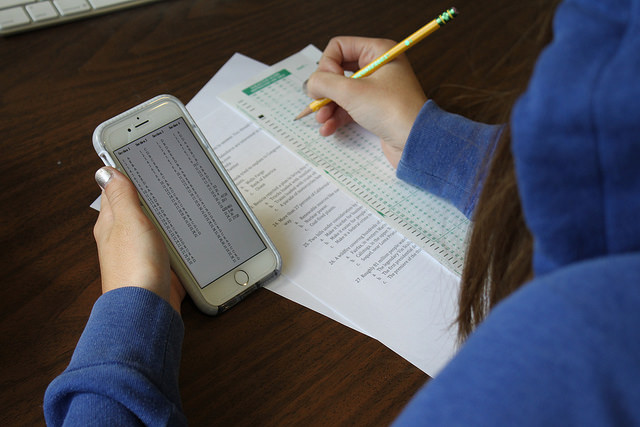Editorial: Professors, let us use phones on our exams
October 10, 2017
Diablo Valley College and its education are behind in relationship to the advancement of technology and its everyday use in the workplace.
College is supposed to prepare students for the workforce. If the students aren’t being taught to adapt to the changes that are constantly occurring in the work force, they’ll be vastly unprepared. Educators are using antiquated methods of teaching that do not translate into marketable employees.
How we learn should reflect our reality, and it’s a virtual one.
At a presentation given in July to the Contra Costa Community College District governing board, a question from a millennial student to the community college faculty read, “Why wouldn’t you let your students use their cell phone during an exam?”
After a class ends, the knowledge may fade, the textbook where the original content came from is returned, sold or outdated because of a revision and then that information is lost to the pupil.
To retain knowledge, one must continually recite the information in order to form a pathway in the brain. And that is what our professors do not each us the material to pass a class. Memorizing is not the way to create a higher level of cognitive ability.
Using cell phones on a test isn’t about cheating, it is about knowing how to find that information, it’s like knowing how the Dewey decimal system works. An educator could work around cell phones as a cheating tool by using timed tests (students that do not know the material well enough could not necessarily be able to search for all the answers in a time allotted) or by using different versions, blocking students from gaining anything by posting tests online.
If we use our phones to literally guide us around outside, teach us new languages through apps like Duolingo, run WolframAlpha to solve multi-step math problems and ask Cortana what the difference between George Orwell and Orson Welles then why don’t cell phones have a rightful place in the classroom?
Education policy advocate publication The Edvocate said embracing technology in the classroom increases equality and provides a customized learning experience. “A student who needs extra. help on a particular topic need not hold up the entire class, or feel embarrassed asking for that help when they are (apps) for individual learning experiences.”
Look, today’s employers are looking for workers who:
• communicate better
• think critically & collaboratively
• are creative in solving problems
• are resilient and push through setbacks
All the things employers are looking for have their place online.
A report put out by the Chronicle for Higher Education said there is a worsening situation of rapidly changing skill requirements. On the demand side of the labor force market, “employers have assumed people will figure out what kinds of skills employers need and acquire them to meet demand. But workers don’t understand where the skills gaps are in the labor market.”
Not doing so could make a student’s education abstract and have no place outside the campus. It’s like taking personal finance in high school, it’s absolutely applicable to the real world.
The Chronicle also published a plea to fellow educators from two professors from Saint Michael’s University and Cornell University that argued for increased technology in courses and for colleges to create implementation plans. Professor Diane Lynch from SMU said, “We (professors) should do it because appropriate delivery — no less than content — makes a difference. We should do it because there is nobody better prepeared or better qualified to teach…and nobody is more dedicated to maintaining the rigor and quality of student learning. And finally, we should it because our students expect it — and deserve nothing less.”
Professors at DVC have incredibly wide discretion in how their students reach their Student Learning Outcomes and should foster an environment of using tech in the classrooms to create a useful employee. Letting students use their cell phones on exams is a start.
~ Fall 2017 Editorial Board

















































































Michael Quinn • Oct 14, 2017 at 9:57 am
Re: “Professors, let us use phones on our exams” (Inquirer, Oct 10, 2017).
I encourage the entire editorial board to read a recent article published by the WSJ: “How Smartphones Hijack Our Minds” by Nicholas Carr. The article cites research that suggests students’ dependence on smartphones “often end up suffering from delusions of intelligence.”